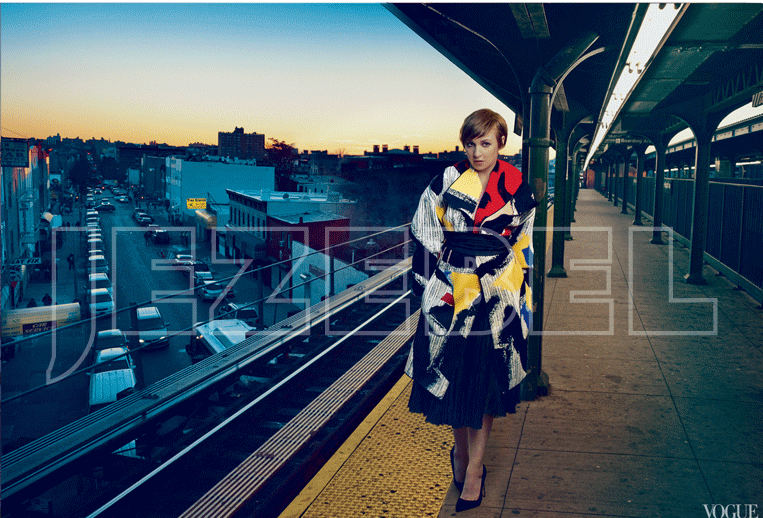So the story is this: Dunham's images for Vogue February 2014 were released, and Jezebel, a women's blog, offered $10,000 for the unretouched versions of the images. Within two hours of the bounty, six unaltered photos were received. The kicker is the photos turned out to be not that heavily photoshopped, and fire has actually come under Jezebel for offering such an amount of money for images they thought would be shockingly different. As the critics say, Jezebel has merely succeeded in implying they thought Dunham's actual body would be less attractive. I like to think how funny it would be if the unnamed source behind the unretouched images was Anna Wintour herself, who pocketed the pretty $10,000 and is snickering in her office as we speak.
Looking at these GIFs, however, I want to address something other than Jezebel. We've all seen those photoshop videos and images where an "average" girl is digitally transformed into a glowing goddess, so much so that sometimes I just want to throw my hands up and say, "All right! I get it!" What's funny is how these dramatic photoshop before-and-afters have lost their effect. We all know the fashion industry favours tiny waists, long legs, sharp faces and impossibly smooth, flawless skin. Does that really stop us from wanting to look like that gorgeous model on the cover? No, because a size 0 figure is so desirable editors are willing to cut inches off a model in order to achieve it.
Dunham's before-and-afters, on the other hand, are different. Here we see adjustments to lighting, clothing, and posture. The puckered shoulder on the cover photo is evened out. The sagging wide-neck on her dress is brought up and tightened. The waistline of the coat is lifted to give better shape, while the legs peeking out are repositioned to heighten the glamour. You might not agree with all of these adjustments, but all in all, these are fairly mundane changes. Sure, her hunched neck has been straightened, her chin defined and her eyebags removed, but is this different from posing and filtering yourself in your Instagram selfies? If you were going to be featured on the cover of Vogue - the bible of the industry - wouldn't you want to look your best? Based on Dunham's reaction to this whole incident, seems like she doesn't mind looking her best. The main point here is that Vogue has featured a different body shape in its issue, and lo and behold, with minimal touch up.
While those dramatic photoshop transformations have never really affected me, it's these minor adjustments to Dunham's photos that truly help me realize perfection is futile. I look at fashion images and envy how the clothing always fits perfectly on the body, yet when I try the pieces on in stores, there are lumps, wrinkles, and bunches in all the wrong places. Looking at Dunham's photos, turns out high fashion pieces lump, wrinkle, and bunch during photoshoots too. I used to envy how models and celebrities were always perfectly positioned in photos and managed to achieve such high glamour. Why can't I look as glamorous just standing there? Turns out a little fixing of posture can hide the fact models don't get their poses right from head to toe all the time either. Thanks to Dunham's photos, I can finally fully accept that as stunning as fashion images are, in reality, they start with a model standing against a dim background with her neckline sagging as she attempts to find the best angle, yet may not manage to achieve it.
How peculiar it is that exposing heavily photoshopped images has less of an impact than simply revealing the amount of effort we're willing to put into erasing the minor inconveniences of life. Fashion images are meant to bring us to a heightened dimension of fantasy (and goodness, we can't have a dress sagging in fantasyland!), and that's why photo editing will never go out of practice, but it's nice to know that behind every flawless image, there was an ordinary, mundane reality.
Image Source: Jezebel





Oh my gosh...I like how you put the photos together showing the before and after..and really? It's a shocking revelation to offer that money to show the unedited photos! I would love to say that natural is always best but with regards to lighting and making images look clear, I guess that perfection is the goal to show the finest images. Over editing which makes the audience believe what is not real is I agree not a good one, but can't deny that I should say whoever invented Photoshop is a genius.
ReplyDelete